Home » Hunting Dogs » The Difference Between a Deutsch-Drahthaar and a German Wirehaired Pointer
The Difference Between a Deutsch-Drahthaar and a German Wirehaired Pointer
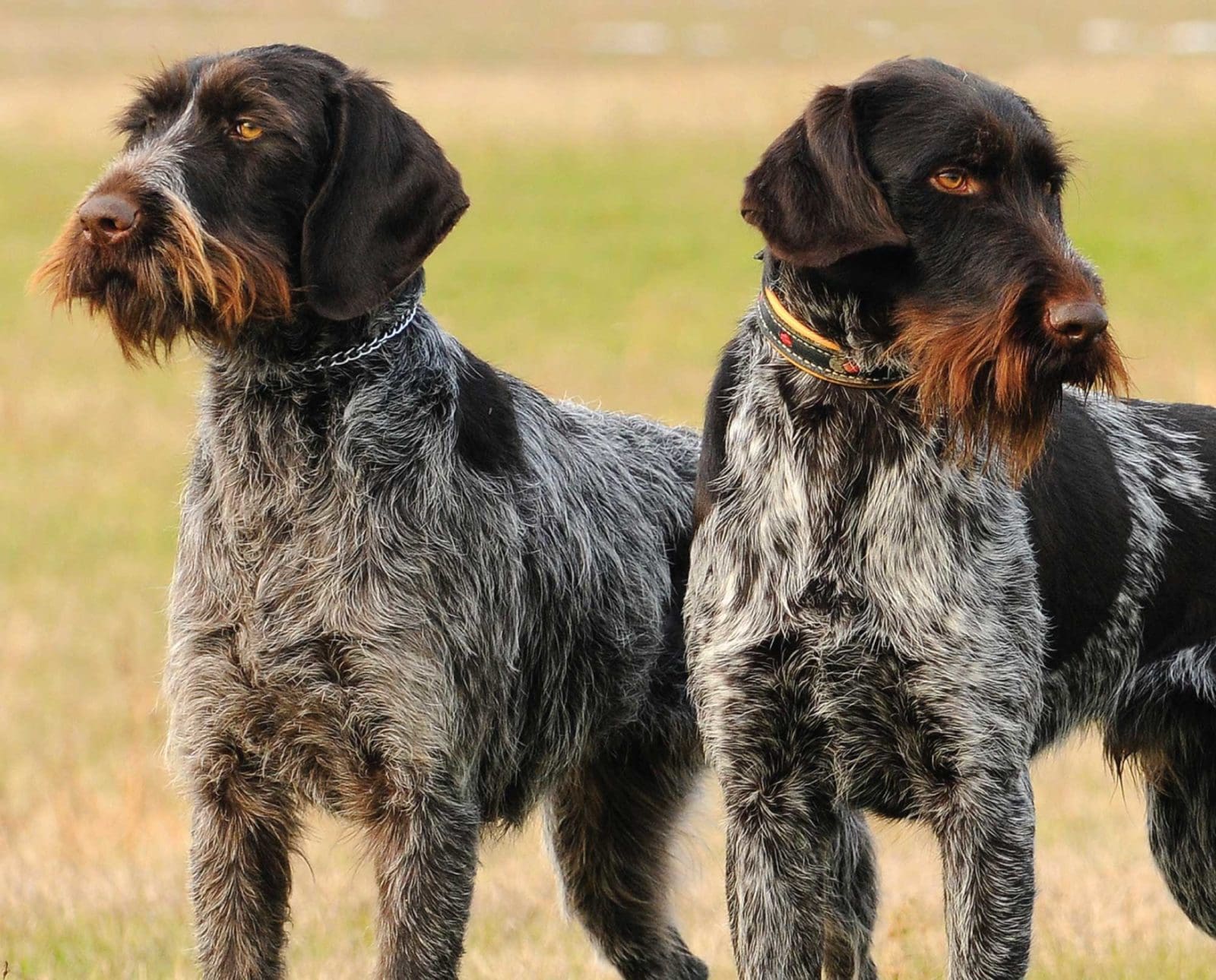
Jennifer Wapenski is the Director of Operations and Managing Partner…
A look at the differences between two wirehaired dog breeds that share a common origin in Germany
Our modern hunting dog breeds have been around for roughly 150 years and, in that time, people have created countless divisions based on politics, preferences, and differing opinions on the best way to create the perfect hunting dog. These divisions yielded a broad spectrum of options when it comes to choosing a hunting dog that works best for you. In some cases, the differences were based on style choices such as color or coat length. In others, such as the division between the Deutsch Drahthaar and the German Wirehaired Pointer, the split came from different philosophies on how to manage the breed.
Listen to more articles on Apple | Google | Spotify | Audible
Brief History of the Deutsch Drahthaar and the German Wirehaired Pointer
The Deutsch Drahthaar was developed by hunters in Germany during the late 1800s in an effort to produce a versatile, wire-coated hunting dog that was well-suited for hunting large and small game in the field, forest, and water. Breeders used other wire-coated hunting breeds such as the Griffon, Pudelpointer, and Stichelhaar along with the short-coated Deutsch Kurzhaar to develop their ideal dog. A national breed club, the Verein Deutsch Drahthaar (VDD), was established in 1902 to maintain the breed standard and promote the Drahthaar among German hunters.
Listen To: East of the Rhine – Pointing Dog Breed Origins
In North America, these types of dogs are known as “versatile hunting dogs;” in Germany, they are called Jagdgebrauchshund or “useful hunting dog.” In other words, they are a do-it-all dog that is equipped for any hunting task, whether it be searching, pointing, tracking, recovering, retrieving, swimming, or laying quietly on the handler’s command. They are not specialists like setters or retrievers; instead, they are expected to perform all of these tasks at a “useful” level of proficiency. As such, the VDD adopted minimum performance requirements in addition to the breed’s conformation standard. Even today, all Deutsch Drahthaars must meet these performance requirements along with health, temperament, and conformation requirements before they can be bred.
When the Drahthaar arrived in North America, hunters soon saw the value of a tough dog that was well-suited for many different hunting scenarios. The breed’s popularity grew, but the American-born puppies were now being produced outside of the German system that enforced those breeding regulations. Eventually, a breed club was formed, and they wrote their own standard for the German Wirehaired Pointer (GWP). The American Kennel Club (AKC) recognized the breed in 1959 and established the German Wirehaired Pointer Club of America as the parent breed club in the United States.
As the American-bred German Wirehaired Pointer started to diverge from the original traits of the Deutsch Drahthaar, some American hunters and breeders wanted to go back to the German performance-based system. The VDD-GNA, a stateside chapter of the German parent club, was formed in 1971 to produce and maintain Deutsch Drahthaars in the United States under the authority of the German breed club. They used the German-language name for the breed in order to differentiate from the AKC German Wirehaired Pointers.
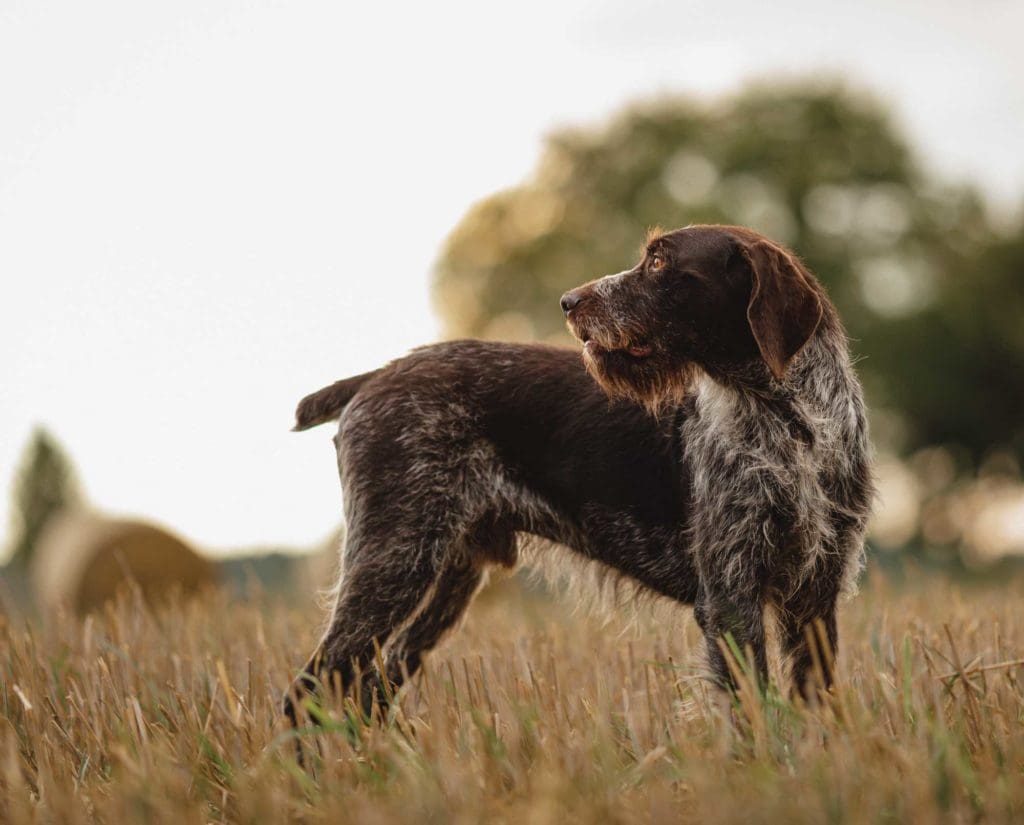
What’s in a name?
Deutsch Drahthaar directly translates as “German Wirehair”, so it’s easy to see the source of confusion when discussing them as two different breeds. Add in the fact that German Wirehaired Pointers all originated from Deutsch Drahthaars and, at least for those who aren’t entrenched in the German versatile dog world, the line can become awfully fuzzy.
The German-language name, Deutsch Drahthaar, is used in North America to designate dogs who have been bred within the German versatile hunting dog system. This means that dogs are tested in Jagdgebrauchshundverband (JGHV) performance tests, evaluated against the German breed standard, and screened for breed-specific health conditions such as hip dysplasia and other disorders before they can be bred. Drahthaars are issued papers by the parent club in Germany and are fully recognized as “equals” to their relatives born across the ocean.
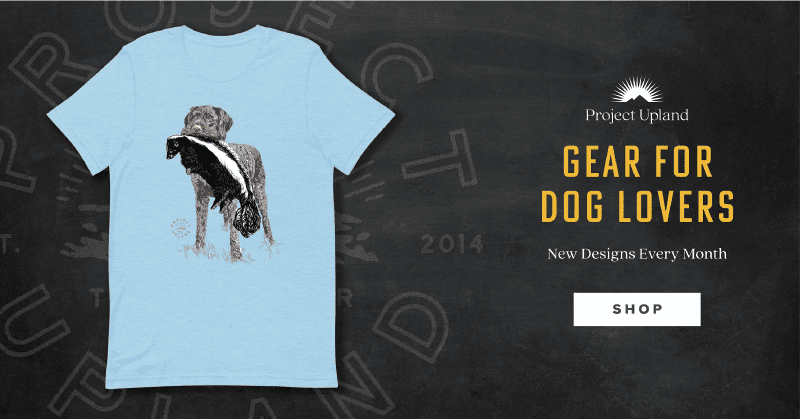
READ: Comparing NAVHDA, JGHV, and AKC Hunting Dog Tests
The German Wirehaired Pointer breed name is less specific because it could refer to a dog registered with the AKC, the United Kennel Club (UKC), the North American Versatile Hunting Dog Association (NAVHDA), some combination of these clubs, or none of the above. These organizations do not impose breeding regulations, so individual breeders are free to follow their own preferences or self-assigned rules. For example, some German Wirehairs are bred to run big and perform well in horseback field trials, some are bred to perform better in versatile hunt tests, and some are bred as companion dogs with no emphasis on hunting abilities. They are all called German Wirehaired Pointers because of their pedigree which demonstrates their purebred lineage, not because of any performance-based attributes.
When is a Wirehair no longer a Drahthaar?
With their shared origin, defining the point at which German Wirehaired Pointers and Deutsch Drahthaars split can often be a source of confusion. Unlike other breed splits that happened at the club level when, for example, a certain color fell out of favor, the division between a Drahthaar and a Wirehair can happen at any point in a dog’s lineage if the breeding requirements are not met. Consider the following two hypothetical scenarios:
- Two VDD-registered Deutsch Drahthaars are performance tested, screened for the necessary health clearances, and receive a passing conformation evaluation by certified judges. By meeting all of these requirements, each dog achieves breeding certification. When bred together with the approval of the VDD, their offspring will be considered Deutsch Drahthaars and can be registered with the VDD.
- One of those VDD-registered Deutsch Drahthaars does not meet the performance requirements at the hunt test and therefore does not receive a breeding certification. Any puppies produced by this dog cannot be considered Deutsch Drahthaars and cannot be registered with the VDD. They can, however, be considered German Wirehaired Pointers and registered with the AKC, NAVHDA, or other organizations.
A person could look at these two scenarios and wonder what all the fuss is about. After all, the genetics are identical in both scenarios and the difference comes down to simply passing a hunt test or getting cleared for hip dysplasia. Is it really enough to lose the breed name? This is when some people will argue that the Drahthaar vs. Wirehair debate is simply a matter of paperwork, and in this scenario, they aren’t wrong.
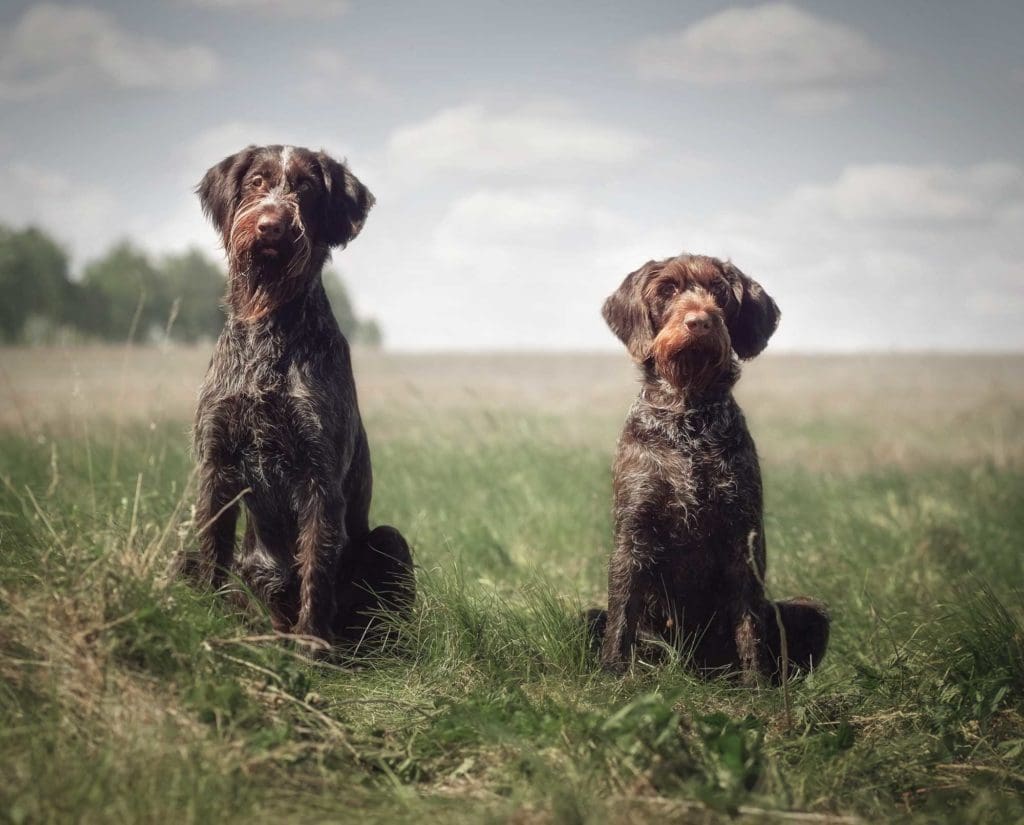
However, consider what happens in two, five, or fifty generations after these hypothetical puppies are born. The Deutsch Drahthaar puppies who remained in the German system are still being held to the same performance, health, and conformation standards as their ancestors. They will be bred within the gene pool of other Deutsch Drahthaars who have completed the same requirements. This means the dogs will generally look and perform the same, generation after generation. The offspring of the German Wirehaired Pointer puppies who were excluded from the German system will be bred within the gene pool of German Wirehaired Pointers and could follow any number of paths based on breeder preferences; as the generations continue, there’s a larger potential for divergence from the original characteristics.
Is a Drahthaar better than a Wirehair?
In a word, no. Deutsch Drahthaars and German Wirehaired Pointers are ultimately considered separate breeds with different gene pools and potentially different characteristics, but neither is inherently superior. As with any other breed choice, the best decision comes down to the dog that is right for you.
The German system, which is based on pass/fail qualification, produces consistency above all else. Whether the results of this consistency are a good match for you depends on what you’re looking for in a hunting dog. Drahthaars are designed for the German-style of hunting, which includes a lot of forest work and significantly more furred game than the average American hunter ever pursues. The dogs are expected to have a high prey drive, an intense desire to search and find game (both feathered and fur), a boldness around other predators, and enough cooperation to channel all of that drive into a useful hunting companion. They can blood track wounded big game, find a quail in a dense thicket, track and sound off on a hare, recover a duck from icy water, and stand down a raccoon encountered in the field. If you aren’t prepared to give them plenty of year-round opportunities to use all of these skills, you will likely be unhappy with the outlets they invent for their excess drive.
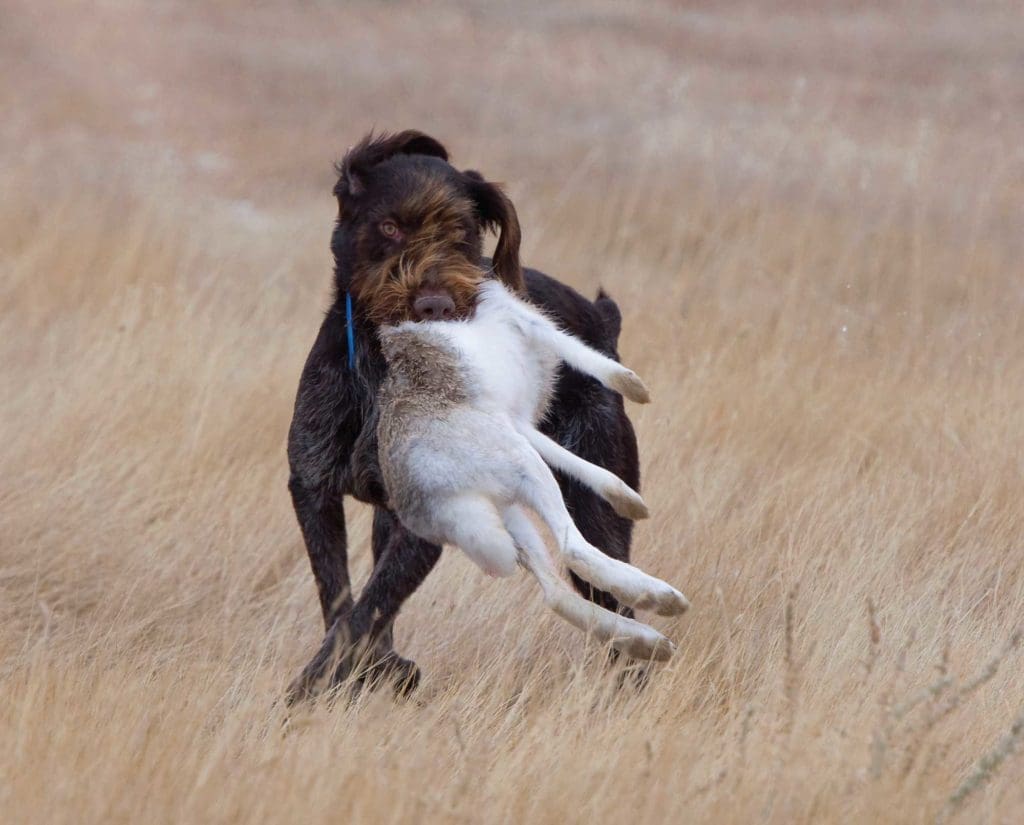
German Wirehaired Pointers may be exactly the same as Drahthaars or they may have very different characteristics depending on their individual genetics. In many cases, the fur drive has been toned down significantly because American hunters usually demand more bird-finding skills from their hunting dogs. With enough research, you can find a Wirehair that suits your own personal preferences, whether you hunt open land off of horseback or want a calm service dog with less prey drive. You can find a Wirehair that’s primarily white, one that is all brown, or anything in between. There’s a lot of flexibility within the breed because there is no single governing organization that controls all breeding activities. If you’re open to doing some research, the possibilities are broad.
Choosing between a Drahthaar and a Wirehair
While you’re deciding which breed is best for you, it’s also important to consider the communities that exist alongside the breeds, especially if you are looking to get involved in an organization to compete or test your dog. If you have plans to breed your dog, then it’s especially important that you fully understand the culture and requirements of the different communities.
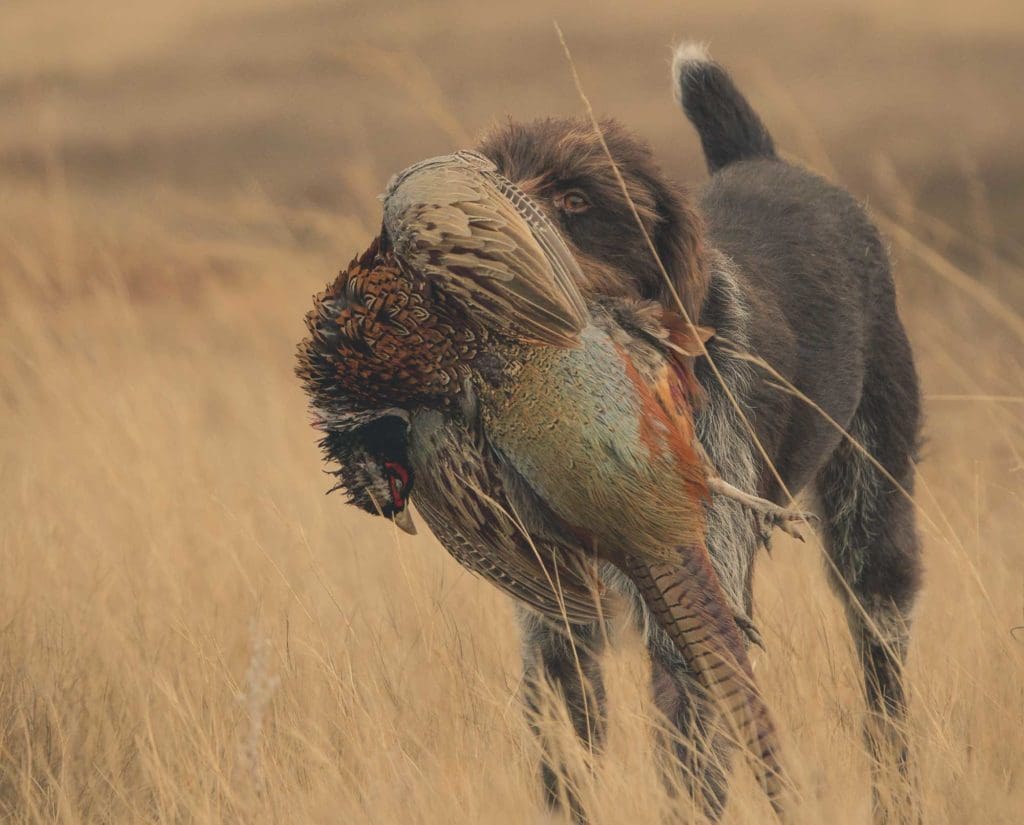
As is evident in the description of breeding requirements, the system that produces the Deutsch Drahthaar is strict and prescriptive, which is not a good fit for everyone. The people involved tend to be intensely devoted to their dogs and firm believers in the merits of the German performance-based system. After all, it takes a lot of dedication to train for and travel to the JGHV hunt tests, so it attracts a certain type of “all-in” personality. As a self-identifying “all-in” JGHV enthusiast myself, these are my people and I respect them immensely. That said, I completely understand that it isn’t for every hunter or dog owner out there. While all puppy buyers are not required to run in hunt tests, it is strongly encouraged, so there’s a certain expectation that you’ll be willing to at least test at the natural ability level.
You will find German Wirehaired Pointer enthusiasts who are every bit as dedicated and fanatical as the Drahthaar folks. Like the dogs themselves, the various Wirehair communities fit a broad spectrum of profiles. There are supportive communities out there whether you are interested in hunt tests, field trials, the conformation ring, or any combination of activities. If you simply want to hunt with your dog and have no plans to participate in organized dog activities, there’s no judgment there, either.
In the end, when it comes to choosing a hunting dog, the choice is a personal one. Consider the overall traits of the breed, the community that exists around the dogs, and any individual breeders that you particularly like and trust. Rather than trying to fit your lifestyle around a dog, you should look for a dog that fits well with your own style and preferences. Whether that’s a Drahthaar, a Wirehair, or something entirely different, the best decision is an educated one.
Jennifer Wapenski is the Director of Operations and Managing Partner at Project Upland Media Group. She has a lifelong passion for the outdoors, dogs, and wildlife; as an adult, she discovered that upland bird and waterfowl hunting were natural extensions of these interests. What started as initial curiosity soon escalated into a life-changing pursuit of conservation, advocacy, and education. Jennifer serves in a variety of roles such as the Breed Warden for the Deutsch Langhaar—Gruppe Nordamerika breed club and on an advisory committee for the Washington Department of Fish and Wildlife.



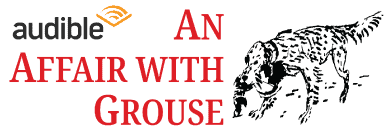


This is a very complete and accurate assessment. I have owned and loved three DDs. Two passed the VGP test and were/are NAVHDA Versatile Champions. The third is young and still in training. DDs are great dogs and companions and I love the breed. That said, it irks me when some DD owners act like their dogs are superior to AKC GWPs just because they are DDs. I have competed in gun dog trails against and tested with many really great GWPs that I would own in a heart beat. The breeding line counts greatly but, more importantly, the difference between a mediocre (or poor) hunting dog and a great one comes down to the owner and the dog’s training. I’ve see more than a few DDs that never reached their full potential because of their owner/trainer. Frankly, I have no issue with someone calling one of my DDs a GWP. In fact I frequently do so myself with people that I presume would have no clue what a DD is.
I was unaware that DDs could test with NAVHDA for titles like Versatile Champion? Same for AKC titles. I have both DD and GWPs right now… and have raised and trained and hunted DDs since 1982.
Yep they can test in NAVHDA. I have a draht that just ran an NA test this past April. NAVHDA simply places a breeding restriction on their registration in order to maintain good standing with the VDD.
Mr. Shickle,
Great post, and I have also met some snobby DD owners who snub their nose at GWP, and I’m glad that you can cut through the B.S. and see an awesome breed for what it is regardless of what name, or Organization it is registered with…
I bet I’ve met more snobby GWP owners who have snubbed their noses at the difference between the two.
Nice read, very interesting. I have wondered about the difference for a while now. Now I know. Thanks
Thank you for the article and the platform of discussion.
There are few things you find out in life that you never bring up in conversation. Politics, religion, and GWP vs. DDs.
As an owner of a DD, and certainly not and expert nor elder in representing this fine breed, you soon find out what a huge “can of worms” can be opened when the topic is at hand. I have been on the receiving end of many flip and even heated confrontational remarks directed my way due to being a supporter of the breed that I dearly admire.
GWP and DDs in my opinion, went down “different forks in the road” in objectives. Objectives to fulfill personal wants and needs.
It all comes down to, in my opinion, is objectives that create the standardization of the definition at hand. What is a definition in relation to anything else? It is the statement expressing the essential nature of something. For example, what makes a measurement a measurement? What separates the color red from orange? What makes a Harrier different form a Beagle? Its all “horseshoes and hand grenades” to the generalized bystander right?
Why has Man manipulated the species of dog over generations to create certain characteristics, like temperament, furnishings, height, etc.? Its to achieve an objective.
Take for example my DD. He has a perfect topline required by a grand champ, exceptional furnishings, and a gait to kill for. But in the show ring, you could not fool an AKC judge or professional handler that he is a GWP. His schwarzschimmel (black in color) coat, larger paws, to name a few of many attributes, would stand him out as not an AKC prototype of perfection to the definition.
Some may say, “well thats the show ring” and isn’t a field breed design. Thats “apples and oranges” in the dog world. Like many breeds, isn’t that the truth? It comes back to what is the definition, a statement expressing the essential nature of something, essence of the purpose. Why isn’t there acceptance in the show ring of all dogs under the same breed the goal of standardization and clarification of the definition?
The essence of a “versatile” hunting dog, is for the “common person” to have ONE dog at his or her disposal to aid in every hunting situation that comes to hand. The “common man” with limitations to “one dog” rather than a kennel full of specified breeds like hounds, setters, pointers, retrievers to be represented every situation only a rich or “well to do” hunter can possess.
What is “versatility”? Its a much different definition to may different people, to many different regions in the world, to many different situations. Would you say versatility in hunting is pointing, flushing, retrieving of different types of birds the definition of versatility? Many say yes. To many that is what they hunt and that is what they require to fulfill an objective of versatility.
How about including hunting hares and rabbits? How about wild boars, coyotes, foxes, bobcats, deer, bear, raccoons, blood tracking etc? Isn’t that versatility? Maybe the true definition of versatility? Isn’t testing for all aspects of the dog the only way to truly and objectively certify these questions?
All these questions and statements are not unique to DDs and GWPs. There are plenty of, usually sporting, breeds that originate and are perfected in the “old world” have been altered, for many reasons, over time to “play by the rules” of others, for example in the USA and other parts of the world.
And I couldn’t resist… my final statement or “jab” to the GWP people out there… Would you rather have new improved COKE or the original COKE classic? I think we all know the answer that that one… Good day!
Yes. The author also forgot to mention the third rough coated mother line: The Stichelhaar.
2 nd paragraph under history
Very nice article. I got my first GWP in ’63 and have been importing DDs since ’83.
Where does the WPG come into the mix?
Every country has modified the pointing breeds to fit the local traditions and environment.
The American GWP guys have not done anything unique in this regard.
The same process took place in France and Italy (and some other European countries as well) with regards to the DD and DK. The hunters in the countries realized that they didn’t need all those natural traits the DD and DK had had in Germany. So, they started modifying them. If you see a French GSP (on You Tube) it’s very different from a German DK. It’s pretty much a brown Pointer with docked tail. Their versatility is limited to retrieving a shot bird. And that’s it.
If I were a pure upland hunter and wanted to import a GSP, the French GSP would be my first choice.
The same goes with GWP In Italy. They turned them into almost a pure upland dog that has a style of gait comparable to the British breeds.
However, later some people in France, Italy and Spain realized they were moving away from the original type of DD and DK. The modification turned into intended outcomes such as unnecessary speed, faded retrieving instinct and complete lack of tracking. It was time to go back. They went to Germany and imported their dogs and started testing them in the JGHV system. They don’t have chapter clubs, but they drive to Germany to do the testing and evaluation. These people represent not even a 5 percent of the French or Italian GSP/GWP enthusiasts but they are there and they are slowly growing.
Like in US, there are people in other countries who think regulated breeding philosophy with an emphasis on versatility is more important and it should supersede the local desire to modify the breeds. And there also people who think opposite to this.
There is no issue here. It’s two different camps.
I believe you can probably try to breed a dog that suits you and your local requirements but still maintain the original intent and the profile of your breed.
Felt like the article described the differences between the rules around what qualifies dogs for each breed, but failed to actually describe the practical differences between the breeds. (If any exist?)
Hi Joy, thanks for reading! The trouble with being able to articulate practical differences is that a DD can “become” a GWP at any time by being bred outside of the German system. So a GWP could be genetically and functionally identical to a DD, or it could have been transformed over many generations to be something very different to suit the breeder’s preferences. I suppose it’s fair to say that the practical difference is that DDs are very consistent due to being universally held to the same requirements, whereas GWPs can run the gamut from versatile fur/feather hunter to upland specialist to field trial champion to service dog to dock diver and everything in between.
Same dogs with different registries. Some gwp breeders concentrate on show vs field but you can’t deny the DNA.
The snobbery is so silly…..But I’ll slap anyone who calls my Llewellin an English Setter! Ha!
Thanks for the article! After watching my friends and their dogs, I’m looking forwrad to getting either a DD or a GWP. Need recommendations on a breeder around the Mid-Atlantic area (PA).
a better comparison is a fully or almost fully white AKC vs the classic VDD colors… its easier to see the gene divisions.. I’m sure you know this but opted not to do it.
Great article Jennifer. One other difference I could think of.. DD owners are the ones who actually train and work their dogs to their full potential. They are the ones whose dogs are retrieving on dove or goose fields in early September, pointing grouse and woodcock in October, sitting by their side in a ground blind next to them during archery deer season, hell maybe even treeing coons and squirrels or trailing rabbits. They know why they’ve got what they got.
It frustrates me when I see hunters who get any versatile breed, and it does little but go to a pheasant shooting preserve a few times each fall. It seems these hunters simply want to look the part. I think it’s wasted talent.
Disclaimer, I own neither GWP nor DD.
Great article Jennifer; I know I’m late to the discussion, but thought you did an excellent job of relaying the similarities and differences! I own 3 GWP’s and hunted/raises GSP’s for over 30 years….went to the wirehair because they’re just so durable! I live in NW Wisconsin and can go from grouse to pheasant…and often at the same time…and my wirehairs are perfect! What hasn’t been discussed is temperament; I own an 11 yr old male(half DD) and since a puppy he’s been very aggressive towards other dogs, especially male dogs. It puts some pressure on us as I make sure we stay clear of other dogs….I’ve actually had 2 GWP males that were aggressive and I’d like to better understand if this is more of a DD issue due to the Stichelhaar breeding? I absolutely love my male and we have harvested so many birds over him… but wish the aggression weren’t such an issue! Any thoughts or am I alone on this issue?
I believe that’s been called ‘sharpness’ or a dog being ‘sharp’ towards another dog. They can also show ‘sharpness’ towards people. I’ve owned a DD for about 12 years now – female. I’ve gotten to know quite a few folks in the DD world, but unfortunately I don’t hunt or train too much these days. I’ve heard of older lines and earlier breedings where this ‘sharpness’ was a desired trait – I am not a breeder and have never bred DDs. So this could be hearsay. In my time at tests, both running my dog and volunteering, I have heard judges discuss ‘sharpness’ and how this trait should no longer be sought out/desired. I have even heard discussions of removing dogs from breeding programs because of aggression/sharpness that was seen/identified by the judges themselves. Whether or not that actually happens and what the proper mechanisms are to identify and remove said aggressive dog…I cannot say. I think most people would want a friendly (or indifferent) dog though…especially here in the states. Hunting can be social and often there are multiple dogs in play. And training with other handlers with their dogs has been incredibly valuable to me/my dog. No one wants to deal with an aggressive dog in those settings. But perhaps the author could provide a little more detail?
I work at the SPCA in Roseville, CA, just north of Sacramento. Maxine (spayed female) is an 89% GWP. Most people want a house pet, so Maxine is less often appealing as she is obviously a field dog. She would make an excellent house pet too, if kept in the right hands. She is somewhat aggressive to other dogs but this may be due to a misunderstanding of the breed. If anyone is interested in Maxine, please call or text: 916-826-3762. Email: randallemails@yahoo.com. Visit our website to view Maxine: placerspca.org. Although we socialize all our dogs twice a day and take them for walks as well, Maxine has been at our facility for several months. She needs a home. Thank you.
Thank you! It was very helpful!
We have had both. Our GWP was beautiful, very protective but agressive towards everyone outside of our family. Bit several people. I read (after the fact) that they were biters, had I known that I would not have purchased this breed. Our DD breeder told us that this breed does is not agressive and if they do bite, the dog is put down. They bred that out of the DD as opposed to the GWP, Both dogs were beautiful and both were great hunters.
A DD is a GWP and A GWP is a DD. If it’s literally only a test of hunting capabilities then there is no difference and the genetics are the exact same. You could have a Yellow lab that is better at retrieving than another yellow lab does that make them a different breed? No. This is all very stupid.